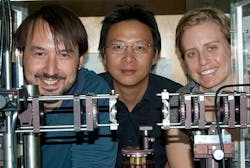Metamaterial flexible sheets from LANL could transform optics
Los Alamos, NM--Research from a team of Los Alamos National Laboratory (LANL) scientists is leading to ultrathin, planar, lightweight, and broadband polarimetric photonic devices and polarimetric optics that would boost security screening systems, infrared thermal cameras, energy harvesting, and radar systems. The research, titled "Terahertz Metamaterials for Linear Polarization Conversion and Anomalous Refraction," was published online May 16 in Science Express, DOI: 10.1126/science.1235399 and aims to replace bulky conventional optics with flexible metamaterial sheets that are about the thickness of a human hair, weigh a fraction of an ounce, and give scientists new levels of control over light wavelengths.
The team demonstrated broadband, high-performance linear polarization conversion using ultrathin planar metamaterials, enabling possible applications in the terahertz (THz) frequency regime. Their design can be scaled to other frequency ranges from the microwave through infrared. "Conventional methods for advanced polarization control impose very demanding requirements on material properties and fabrication methods, but they attain only limited performance," said Hou-Tong Chen, the senior researcher on the project.
Metamaterial-based polarimetric devices (http://www.laserfocusworld.com/articles/print/volume-47/issue-8/world-news/metamaterials-large-area-printed-3d-negative-index-metamaterial-is-flexible.html) are particularly attractive in the terahertz frequency range due to the lack of suitable natural materials for THz applications. Currently available designs suffer from either very limited bandwidth or high losses. The Los Alamos designs further enable the near-perfect realization of the generalized laws of reflection/refraction. According to the researchers, this can be exploited to make flat lenses, prisms, and other optical elements in a fashion very different from the curved, conventional designs that we use in our daily life.
The Los Alamos National Laboratory Directed Research and Development (LDRD) program funded a portion of the research. Part of the work was performed at the Center for Integrated Nanotechnologies (CINT).
SOURCE: LANL; http://www.lanl.gov/newsroom/news-releases/2013/June/06.05-metamaterial-flexible-sheets-transform-optics.php
About the Author

Gail Overton
Senior Editor (2004-2020)
Gail has more than 30 years of engineering, marketing, product management, and editorial experience in the photonics and optical communications industry. Before joining the staff at Laser Focus World in 2004, she held many product management and product marketing roles in the fiber-optics industry, most notably at Hughes (El Segundo, CA), GTE Labs (Waltham, MA), Corning (Corning, NY), Photon Kinetics (Beaverton, OR), and Newport Corporation (Irvine, CA). During her marketing career, Gail published articles in WDM Solutions and Sensors magazine and traveled internationally to conduct product and sales training. Gail received her BS degree in physics, with an emphasis in optics, from San Diego State University in San Diego, CA in May 1986.
